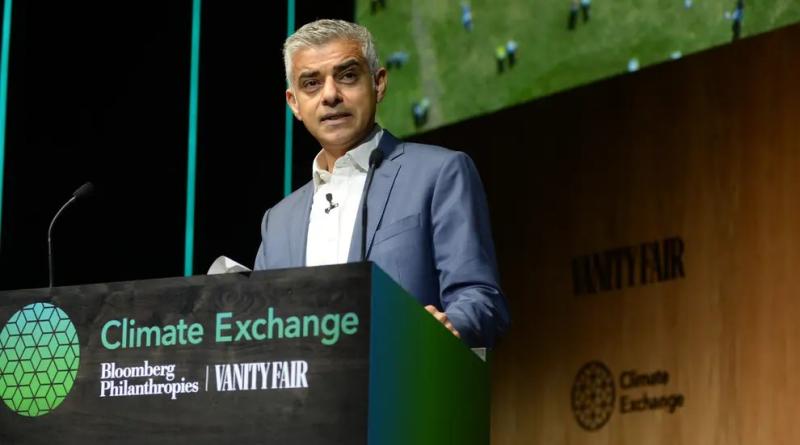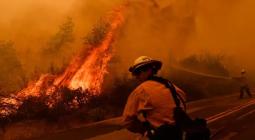Sadiq Khan: ‘Climate crisis is a racial justice issue’ as black and Asian Londoners most affected

The global climate crisis is a matter of racial injustice, the mayor of London has warned, as new research reveals that black, Asian and minority ethnic communities are most at risk of being affected by harmful emissions in the capital.
Areas of London with minority ethnic populations of more than 50 per cent are more likely to face the highest climate risk in London, including flooding, exposure to toxic air, heat risk and limited access to green space, analysis from City Hall shows.
Last year, London saw the impact of the climate emergency first-hand, with soaring temperatures and flash floods in the capital.
Experts caution that if the necessary action is not taken, and extreme temperatures and flooding continue to get worse, a quarter of London’s railway stations, one in five schools, nearly half of London’s hospitals and hundreds of thousands of homes and workplaces will be at risk of flooding in the future.
During an interview with The Independent, the mayor acknowledged that, all too often, headlines and national discussions around climate change fail to resonate with the average person, because of a lack of accessible information about how the average person is affected.
“That’s why we’ve brought together a number of different pieces of research and analysis, because it’s very complicated – and when you look at this stuff, a number of stark things jump out at you,” he said, adding that the climate crisis is already having a significant impact on countries with a majority black and Asian population, some of which have strong links to London’s diaspora communities. These include Bangladesh,
China, Ghana, India, Jamaica, Nigeria, Pakistan, Somalia and Sri Lanka.
“The climate emergency is one of the biggest global threats we face today,” the mayor continued. “On the one hand, we’re seeing racial injustice [manifest] through climate change on a global scale, but even in London, perversely, the effects of the climate crisis won’t impact everyone equally – with the poorest, minority communities and most vulnerable expected to be hit the hardest. Poverty, deprivation and health inequalities will reduce people’s ability to prepare for, respond to and recover from overheating and flooding incidents.
“Minority communities already suffer the worst toxic air, and bigger numbers of additional mortality caused by heatwaves; their homes and places of work will suffer bigger consequences of flash flooding than in other parts of the country. We only have to look at the flash floods in the summer of 2021, and heatwaves in 2020, which led to almost 500 additional deaths.
“In terms of the consequences of climate change, those who have the smallest carbon footprint and are least likely to be responsible for the crisis see the biggest consequences,” Mr Khan said. “That’s why this should be a wake-up call to people of colour in London to understand that the crisis is also a matter of racial injustice – which is, for me, another motivating factor to tackle the problem.”
The London mayor is the chair of the C40 Cities Climate Leadership Group – a coalition of 97 cities around the world that represents one twelfth of the world’s population and one quarter of the global economy.
“We don’t have time to waste; the climate emergency means we only have a small window of opportunity left to help save the planet by reducing carbon emissions,” he added.
“London has a responsibility to act – not only to protect our capital, but to help safeguard the places around the world that we are so fundamentally linked to as a city. That’s why I’m determined to ensure that London continues to lead from the front in tackling air pollution and the climate emergency.”
Taking action to tackle the climate emergency will not only benefit London, but other countries around the globe.
The UN’s Intergovernmental Panel on Climate Change (IPCC) recently released a report that warned that there is only a brief and rapidly closing window to tackle the climate crisis, and laid out the dire consequences of inaction.
In London, the mayor has introduced the world’s first ultra-low-emission zone, which has helped reduce pollution in central London by nearly half at the same time as cutting carbon emissions. Last year in October, the zone was expanded up to the north and south circular roads, in a move that is expected to reduce road transport nitrogen oxide emissions by around 30 per cent.
Mr Khan also recently asked Transport for London to consult on expanding the ultra-low-emission zone London-wide in 2023. This follows the publication of a report last month, which revealed that in order to meet the target of getting to net zero in London by 2030, car traffic must reduce by at least 27 per cent in the capital by the end of the decade.
The ultra-low-emission zone is mainly targeted at getting the most polluting vehicles off the capital’s streets, and early assessments indicate that making it London-wide would, among other benefits, reduce the number of the most polluting cars on London’s roads by between an additional 20,000 and 40,000 a day.
Louise Pryor, of the London Climate Change Partnership, said: “It’s clear that the impacts of climate change don’t affect us all equally. Both in London and worldwide, it is the poorest and most vulnerable who are hardest hit, so it’s good to see London targeting its climate adaptation measures to support our most vulnerable populations and reduce climate inequality.”
Author:Nadine White





